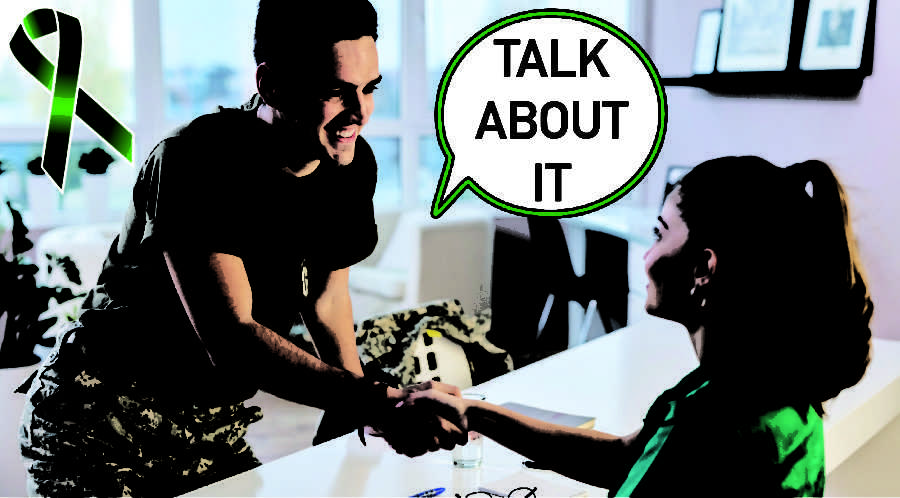Talk About It: Post-traumatic stress disorder
Post-traumatic stress disorder (PTSD) develops when someone experiences a shocking or dangerous event. Six out of 10 men and five out of 10 women will experience at least one trauma in their lives, according to the United States Department of Veterans Affairs.
October 31, 2019
Editor’s note: This is part five in our weekly mental health series “Talk About It.” Sensitive content may follow.
Six out of 10 men and five out of 10 women will experience at least one trauma in their lives, according to the United States Department of Veterans Affairs. Post-traumatic stress disorder (PTSD) develops when someone experiences a shocking or dangerous event.
Kinsey Phillips, mental health advocate for the Iowa State University Police Department, said in her graduate classes her professor had made a distinction of the word “disorder.”
“Our professor started off with introducing [PTSD] as just post-traumatic stress and that’s interchangeable with post-traumatic stress injury, so completely easing off that word ‘disorder’ — which at first I was kind of confused by,” Phillips said. “He later explained it as post-traumatic stress is not something that is a disorder, it’s your body’s coping mechanism […] it’s just something natural that your body does when you go through a traumatic situation.”
Phillips said the word “disorder” could cause people to associate it with a negative connotation.
“I thought it was kind of fascinating and it’s a really neat way to look at it because having the word ‘disorder’ can have kind of a dangerous connotation,” Phillips said. “When you put the word ‘disorder’ on it at the end, it kind of puts a negative light on it.”
About seven percent of the United States population will have PTSD at some point in their lives, according to the United States Department of Veteran Affairs.
Sunde Nesbit, assistant teaching professor in psychology, is a clinical psychologist with a focus on psychological evaluations.
“From my clinical experience I see kids as young as five, six years old that are experiencing negative reactions to trauma,” Nesbit said. “I have seen adults that experience historic trauma and they come in 30 years later and [another issue] comes up, but then there’s this underlying issue that they’ve been pushing aside for years and years and years.”
The evaluation process depends on the age of the person, but they are looking for evidence of those symptoms of PTSD. Nesbit said she can get that information from asking the person who is being evaluated, which can be hard for younger children to remember.
Nesbit said identifying a specific cause to PTSD is “easy and in some ways it’s a lot more complex,” with the basic criteria being a person experiencing an event where their lives were threatened, in danger or there was an absence of safety. Nesbit said the nature of the trauma can dictate the degree of PTSD.
Nesbit said the symptoms of PTSD can be broken into four subjects: negative moods, arousal symptoms, avoidance and intrusion.
For those who experience negative states such as depression, anxiety, anger and irritability, the symptoms of avoidance include staying away from places, events or objects that are reminders of the traumatic experience as well as avoiding thoughts and feelings related to the event.
“If a person experienced a situation in which they felt as though their lives were in danger, then it takes a while for the body’s alarm system to calm down,” Nesbit said. “Individuals who experienced PTSD may experience these arousal symptoms where the body’s alarm system is […] like a faulty alarm system, like it’s going off too much or it’s over activated.”
Symptoms of intrusion could include flashbacks and arousal symptoms can include feeling “on edge.”
“These arousal symptoms would include things like being jumpy or hypervigilant, having trouble with concentration because they’re constantly scanning their environment for danger, challenges with sleep because it’s hard to turn their mind and hard to turn their body off,” Nesbit said.
Cues that remind the person of an event can trigger their reaction and those who have gone through these experiences may not develop PTSD, according to the National Institute of Mental Health.
“So [veterans] had lived for 35, kind of keeping all of it together, and then suddenly in their 50s were coming back in […] were really struggling with coping because they were being reminded of something they were trying really, really hard to forget,” Nesbit said.
Those who have PTSD can experience flashbacks or nightmares. Nesbit said it is possible for people to not experience symptoms of PTSD until later in their life. Nesbit said she worked at a veteran’s hospital, during her internship in 2005, and saw patients come in for older trauma.
“One of the things that I saw, pretty frequently, was that people — veterans — who had served in Vietnam in the ’60s and early ’70s […] they had managed the negative reactions to the trauma, they pushed it down, they restructured their lives and dealt with it,” Nesbit said. “The constant news of Iraq and Afghanistan on TV were re-triggering [the veterans] and reminding them of their own experiences.”
Nesbit said the type of treatment for PTSD can vary from person to person. Various methods of therapy such as psychotherapy, which involves talking to a mental health professional, as well as medications are potential methods to treat PTSD. According to the National Institute of Mental Health, psychotherapy could teach a person how to react to a symptom of PTSD as well as to identify the emotions connected with the trauma.

















